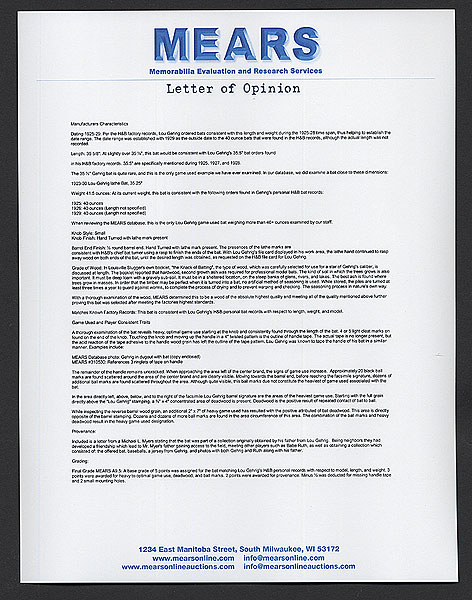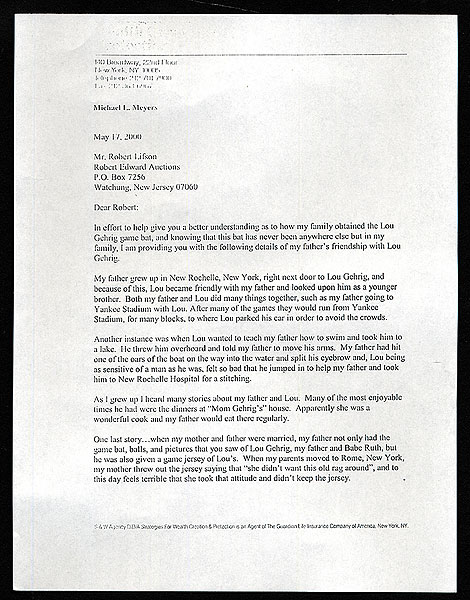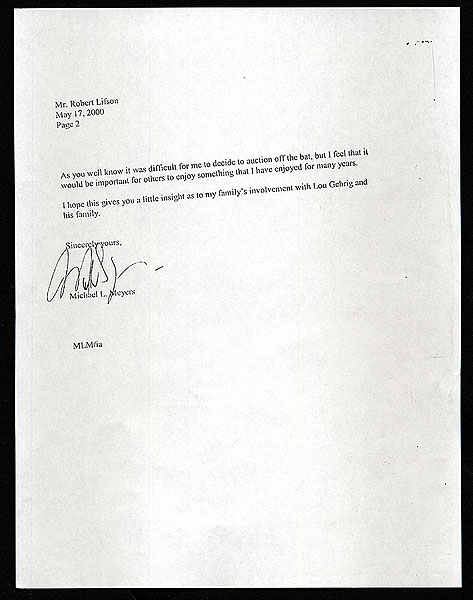Search
1925-1929 Lou Gehrig Pro-Model Bat with Extraordinary Provenance (Personal Gift From Gehrig To His Next Door Neighbor)
Sold For:
$176,250
Year: 1925
Auction: 2011 Spring
Lot #: 6
Auction: Post-1900 Baseball Memorabilia
Lou Gehrig H&B signature model bat (predating model numbers) dating from the five-year period 1925 through 1929. Graded A9.5 by MEARS. The fact that this is an extraordinary high-grade Gehrig bat dating from perhaps the most historically significant period in Yankees franchise history all alone makes this one of the most desirable Gehrig bats in existence. Its remarkable provenance, however, further defines it as one of the finest and most ideal Lou Gehrig bats that could possibly exist! This bat was a personal gift presented by Gehrig to his next-door neighbor in New Rochelle, New York. While we have great respect for sidewriting for verifying that a bat once came from the hands of a player, this is a rare bat that has no leap of faith or mystery as to its provenance. The history of this bat is such that it has practically been handed to us by Lou Gehrig himself! It would be hard to imagine a finer or more desirable example. The bat is accompanied by a two-page letter from the family of Lou Gehrig's neighbor, dated May 17, 2000, to Robert Edward Auctions president Robert Lifson. The letter (written by the son) details the history of the bat and his father's close relationship with Gehrig. In full:
In effort to help give you a better understanding as to how my family obtained the Lou Gehrig game bat, and knowing that this bat has never been anywhere else but in my family, I am providing you with the following details of my father's friendship with Lou Gehrig. My father grew up in New Rochelle, New York, right next door to Lou Gehrig, and because of this, Lou became friendly with my father and looked upon him as a younger brother. Both my father and Lou did many things together, such as my father going to Yankee Stadium with Lou. After many of the games they would run from Yankee Stadium, for many blocks, to where Lou parked his car in order to avoid the terrible crowds...As I grew up I heard many stories about my father and Lou. Many of the most enjoyable times we had were the dinners at "Mom Gehrig's" house. Apparently she was a wonderful cook and my father would eat there regularly. One last story. When my mother and father were married, my father not only had the game bat, balls, and pictures that you saw of Lou Gehrig, my father and Babe Ruth, but he was also given a game jersey of Lou's. When my parents moved to Rome, New York, my mother threw out the jersey saying that "she didn't want this old rag around," and to this day feels terrible that she took that attitude and didn't keep the jersey. As you know it was difficult for me to decide to auction off the bat, but I feel that it would be important for others to enjoy something that I have enjoyed for many years. I hope this gives you a little insight as to my family's involvement with Lou Gehrig and his family.
The family first learned that the bat and other Gehrig items they had saved (they also had various other memorabilia including autographed photos personalized to them from Gehrig) were highly sought after by collectors when the famous Barry Halper auction at Sotheby's was publicized in 1999. When the family visited Sotheby's hoping to find out more information about their items during the auction viewing days in New York, Sotheby's officials directed them to senior consultant Robert Lifson. They were shocked to learn that the bat was so valuable. After much thought, the following year they called to sell the bat at auction.
This bat originally appeared as Lot 1007 in Robert Edward Auctions' May 2000 sale. At this early date, bat collecting was in its infancy as far as sophistication was concerned. The catalog description was just a few short sentences and the letter of provenance was not even quoted, yet even then this bat was recognized as extraordinary by the few most advanced bat collectors of the day. It realized a final sales price of $49,223, which at the time was a world-record price for a Lou Gehrig bat. Its whereabouts have been unknown and the bat has not seen the light of day since. It has been consigned to this auction directly from the original purchaser. At the time of the original sale, bat authentication was a newly emerging field and today much more information regarding this bat is available, all of which makes this bat even more remarkable. While this bat conforms to the general 1921-1931 manufacturing period, it can be more narrowly dated to the five-year span 1925 through 1929 based upon its specifications and information found within the H&B ordering documents. This bat measures 35.6 inches in length and weighs 41.5 ounces. As MEARS notes in its accompanying LOA, both of those specifications are very significant with regards to dating: "This bat would be consistent with Lou Gehrig's 35.5" bat orders found. The 35 1/2" Gehrig bat is quite rare, and this is the only game-used example we have ever examined...in his [Gehrig's] H&B factory records, 35.5" are specifically mentioned during 1925, 1927, and 1928..." The years 1925 through 1929 not only marked Gehrig's first five full seasons in the Major Leagues, but also the period in which the New York Yankees built its first great baseball dynasty, with the 1927 club regarded by many as the greatest ever assembled. Gehrig, of course, with Ruth, formed the heart of the club's fabled "Murderers' Row" lineup. From 1925 through 1929 Gehrig averaged 29 home runs and 125 RBI per season, as well as a .331 batting average.
The heavy amount of use displayed along the entire length of this bat is indicative of that prodigious output. In addition to game use, the bat also displays an extremely tiny "batboy" nail just to the right of the barrel stamping, and three additional tiny holes where it appears nails were removed (most likely applied in repair of the dead wood, a very common practice to prolong the life of a favorite bat). Both the substantial amount of game use and its remarkable provenance have contributed to its extraordinary final MEARS grade of A9.5 (5 point base grade, plus 3 points for use and 2 points for provenance, but minus a half point for the missing handle tape). While its specifications, appearance in the H&B records, and amount of use on this bat all alone combine to make this one of the finest Lou Gehrig bats in existence, the fact that it was a personal gift from Lou Gehrig to his next-door neighbor makes this bat special in a way that few others can claim. It"™s unique and very significant provenance literally puts the bat in Gehrig's hands and defines it as by far the most extraordinary Lou Gehrig game-used bat we have ever seen, let alone offered, and one that would be a centerpiece in even the most advanced Hall of Fame bat, New York Yankees, or Lou Gehrig Collection. LOA from Troy Kinunen/MEARS. Reserve $25,000. Estimate $50,000++. SOLD FOR $176,250
In effort to help give you a better understanding as to how my family obtained the Lou Gehrig game bat, and knowing that this bat has never been anywhere else but in my family, I am providing you with the following details of my father's friendship with Lou Gehrig. My father grew up in New Rochelle, New York, right next door to Lou Gehrig, and because of this, Lou became friendly with my father and looked upon him as a younger brother. Both my father and Lou did many things together, such as my father going to Yankee Stadium with Lou. After many of the games they would run from Yankee Stadium, for many blocks, to where Lou parked his car in order to avoid the terrible crowds...As I grew up I heard many stories about my father and Lou. Many of the most enjoyable times we had were the dinners at "Mom Gehrig's" house. Apparently she was a wonderful cook and my father would eat there regularly. One last story. When my mother and father were married, my father not only had the game bat, balls, and pictures that you saw of Lou Gehrig, my father and Babe Ruth, but he was also given a game jersey of Lou's. When my parents moved to Rome, New York, my mother threw out the jersey saying that "she didn't want this old rag around," and to this day feels terrible that she took that attitude and didn't keep the jersey. As you know it was difficult for me to decide to auction off the bat, but I feel that it would be important for others to enjoy something that I have enjoyed for many years. I hope this gives you a little insight as to my family's involvement with Lou Gehrig and his family.
The family first learned that the bat and other Gehrig items they had saved (they also had various other memorabilia including autographed photos personalized to them from Gehrig) were highly sought after by collectors when the famous Barry Halper auction at Sotheby's was publicized in 1999. When the family visited Sotheby's hoping to find out more information about their items during the auction viewing days in New York, Sotheby's officials directed them to senior consultant Robert Lifson. They were shocked to learn that the bat was so valuable. After much thought, the following year they called to sell the bat at auction.
This bat originally appeared as Lot 1007 in Robert Edward Auctions' May 2000 sale. At this early date, bat collecting was in its infancy as far as sophistication was concerned. The catalog description was just a few short sentences and the letter of provenance was not even quoted, yet even then this bat was recognized as extraordinary by the few most advanced bat collectors of the day. It realized a final sales price of $49,223, which at the time was a world-record price for a Lou Gehrig bat. Its whereabouts have been unknown and the bat has not seen the light of day since. It has been consigned to this auction directly from the original purchaser. At the time of the original sale, bat authentication was a newly emerging field and today much more information regarding this bat is available, all of which makes this bat even more remarkable. While this bat conforms to the general 1921-1931 manufacturing period, it can be more narrowly dated to the five-year span 1925 through 1929 based upon its specifications and information found within the H&B ordering documents. This bat measures 35.6 inches in length and weighs 41.5 ounces. As MEARS notes in its accompanying LOA, both of those specifications are very significant with regards to dating: "This bat would be consistent with Lou Gehrig's 35.5" bat orders found. The 35 1/2" Gehrig bat is quite rare, and this is the only game-used example we have ever examined...in his [Gehrig's] H&B factory records, 35.5" are specifically mentioned during 1925, 1927, and 1928..." The years 1925 through 1929 not only marked Gehrig's first five full seasons in the Major Leagues, but also the period in which the New York Yankees built its first great baseball dynasty, with the 1927 club regarded by many as the greatest ever assembled. Gehrig, of course, with Ruth, formed the heart of the club's fabled "Murderers' Row" lineup. From 1925 through 1929 Gehrig averaged 29 home runs and 125 RBI per season, as well as a .331 batting average.
The heavy amount of use displayed along the entire length of this bat is indicative of that prodigious output. In addition to game use, the bat also displays an extremely tiny "batboy" nail just to the right of the barrel stamping, and three additional tiny holes where it appears nails were removed (most likely applied in repair of the dead wood, a very common practice to prolong the life of a favorite bat). Both the substantial amount of game use and its remarkable provenance have contributed to its extraordinary final MEARS grade of A9.5 (5 point base grade, plus 3 points for use and 2 points for provenance, but minus a half point for the missing handle tape). While its specifications, appearance in the H&B records, and amount of use on this bat all alone combine to make this one of the finest Lou Gehrig bats in existence, the fact that it was a personal gift from Lou Gehrig to his next-door neighbor makes this bat special in a way that few others can claim. It"™s unique and very significant provenance literally puts the bat in Gehrig's hands and defines it as by far the most extraordinary Lou Gehrig game-used bat we have ever seen, let alone offered, and one that would be a centerpiece in even the most advanced Hall of Fame bat, New York Yankees, or Lou Gehrig Collection. LOA from Troy Kinunen/MEARS. Reserve $25,000. Estimate $50,000++. SOLD FOR $176,250






